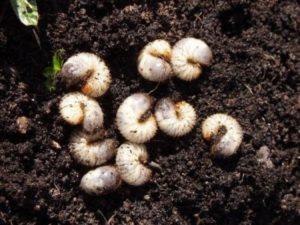Useful larva of the bronzovka beetle: how to distinguish it from the harmful May beetle
In every garden you can see a very beautiful bronze beetle with an emerald color. The metallic color plays beautifully in the sun. However, only adults have such an original shade. The larva has an inconspicuous appearance.
Content
Description of the bronze larva
The bronze larva has a thick, hairy body. It has a C-shape. Color whitish grey. The largest body size reaches 6,2 cm. The head and jaws are small, the legs are short.
There are no claws on the limbs. Because of this, they move on their backs. The habitats of the larvae are anthills, rotten wood, rodent burrows, forest litter.
The benefits and harms of bronze larvae
The bronze larva does no harm. The larvae of the May beetle, which are very similar to the larvae of the bronze, are engaged in gnawing the roots of plants.
The diet of Bronze larvae consists of detritus of plant origin - dead, undecayed plant remains. Roots and living plants are of no interest to them.
It is worth noting that there is a certain benefit from bronze larvae. During their life cycle, they constantly eat. With the help of their jaws, they crush rotting plant debris, which accelerates the decomposition of solid particles.
From the dead plant parts, after digestion in the digestive system, a substance is formed that increases the fertility of the earth. Excrements during their cycle are allocated in an amount exceeding their weight by several thousand times.
Such a fertilizer is better than the performance of earthworm biomaterial.
The difference between the larvae of the bronze and the larvae of the May beetle
The larvae of the bronzovka and the May beetle are very similar in appearance. However, if you look closely, you can find differences.
Conclusion
An adult bronze beetle causes damage in summer cottages. In the fight against the pest, gardeners put a lot of effort. However, the bronze larva does not feed on plants and roots. Its feces can fertilize the soil, which will contribute to a good quality crop.

